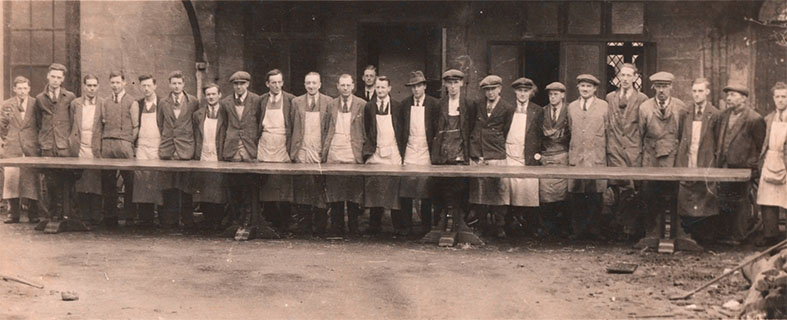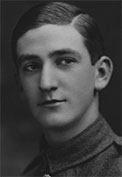- Screen Colours:
- Normal
- Black & Yellow

Above: An oak table, 26 feet long, made by Titchmarsh & Goodwin for Worksop College Nottingham
In this 21st century we are inclined to look upon reproduction furniture as very dated and certainly not on-trend. However, during much of the 20thcentury, Ipswich was one of the world’s leading manufacturers of period styles. Two firms dominated; Tibbenhams and Titchmarsh & Goodwin, the former being inspiration for the latter which has endured to reach its centenary on the 20 May 2020.
In 1904 young Frederick Tibbenham began working in Tudor Place off Woodbridge Road. By 1912 he had moved to Turret Lane and Lower Brook St. He built up a strong workforce of superb craftsmen, at one point employing around six hundred. In 1941 the firm was sold to the Lipert brothers, of Easterns retail chain who later sold to others before the name finally died out.
One wonders if Frederick had been aware of the school leaver, young Gordon Owen Goodwin, employed in his drawing office. We know that in his brief time at Tibbenhams, Gordon was observant, noting the firm’s construction processes and the importance of finishing and distressing. Born 7 January 1897, Gordon was the youngest of seven children living in Tacket Street; their father was an accomplished carpenter who could turn his hand to many skills. When he died in 1915 the family moved to 64 Christchurch Street. It was perhaps fortuitous for Gordon that World War I began before his career at Tibbenhams became intrinsically ingrained. Like many young men of his era, he was keen to defend his country and very soon he was in trenches on the front-line in France. He spoke later of infernal lice particularly around his collar which in quiet spells he attempted to burn off with match flames. Again, probably a lucky event – although at the time it must have been devastating – mustard gas brought him for convalescence to the Isle of Wight. He had lost sight in an eye, but still had his life.
Whilst working at Tibbenhams he had attended the Art School on a part-time basis where Rushton was head and the well-known Suffolk artist Leonard Squirrel was a fellow student. Gordon dreamt of his own furniture company but had no financial resources, however, his brother-in-law Frederick Titchmarsh, an accountant who had married one of Gordon’s sisters, lived just a few doors from his home at number 72 Christchurch Street (now the Beverley Court flats). The two collaborated and on 20 May 1920 their equal partnership to be known as Titchmarsh & Goodwin was in operation in premises at the back of Roundwood (once briefly owned by Lord Nelson). The pair had taken over an existing company of joiners, Lomax and Childs retaining many of the men, then gradually some of Tibbenhams employees became attracted to the new venture.
In March 1924 Titchmarsh purchased a builder’s yard almost at the top of Back Hamlet for £665 which was probably a very reasonable price as it was close to the ‘Potteries’ and prior to the 1935 slum clearance act was not deemed to be a very salubrious area. Now Gordon was ready for action. Initially Gordon was drawing all the designs, but as the business developed it became increasingly necessary to employ a team in the drawing office (pre-WWII there were seven).
Solely English oak was used in those early years, much of it being pit-sawn. Gordon’s keen eye saw that carvings were true to period, polishing was a nutty brown and the distressing well considered. Although not making much money Gordon was employing about sixty people who were producing the period pieces he adored; he had found his niche. He married Winifred Edwards of the J.J. Edwards (outfitters) family in 1929 and they had three sons: Jeremy, Guy and Roger but sadly in 1935 just a few months after Roger’s birth, Winifred died.
In 1931 the partnership between Gordon and Frederick was amicably dissolved and it was agreed that the firm should continue trading under the same name. During the economic depression of the 1930s lots of architectural woodwork was undertaken: panelled rooms, staircases, etc. Sites included Worksop College in Nottingham, Ripley Grange in Essex, Little Aston in Warwickshire and more including various public houses for Cobbold Breweries: the Margaret Catchpole, Royal George, Gainsborough, Railway and Station Hotels.
Gordon’s second marriage to Gweneth Alderton in 1939 just preceded WWII then a fourth son, Peter, was born in 1942. An extensive showroom in London’s Dean Street was destroyed by German bombs less than two years after its opening, but despite wartime restrictions most employees were kept busy at Back Hamlet. Veneered work was introduced to the range with walnut bedroom and dining suites. Later Brazilian and Cuban mahogany, English yew-tree and other timbers were used. Firstly Jeremy and then Peter became directors, each bringing their individual strengths. Jeremy had good business sense and was keen to put the work through in quantities – fives, tens and more of popular designs. He also found an agent in Germany and located an outlet in New York. Peter, meanwhile, found Dutch, Belgian and Canadian retailers. T&G furniture was going global with presidents, princes, celebs and many more seemingly preferring a T&G reproduction to the antique.
In 1963 a fire destroyed the workshops but fortunately most of the drawings were saved. Gordon was despondent but Jeremy insisted new premises should be built and immediately engaged architects Basil and David Hatcher. For a while the craftsmen worked in an aircraft hangar at Martlesham until completion of the new workshops and office in the autumn of 1964. Like a phoenix rising from the ashes orders flew in with delivery dates extending from weeks to months.
 Later in life Gordon had a partial detachment of his good eye but he remained as observant as ever, running his hands over turning details to ensure their shape was right, getting close-up to drawings with his ‘spy-glass’ and often declaring them, ‘Delicious!’. His love for good craftsmanship was with him to the end.
Later in life Gordon had a partial detachment of his good eye but he remained as observant as ever, running his hands over turning details to ensure their shape was right, getting close-up to drawings with his ‘spy-glass’ and often declaring them, ‘Delicious!’. His love for good craftsmanship was with him to the end.
For many years T&G managed Witnesham Sawmills and Peter became responsible for locating most of the standing timbers within various East Anglian estates, he also initiated a replanting scheme. In the 1990s he co-founded ‘Woodland Heritage’ a truly great legacy.
Prior to their deaths, Jeremy and Peter sold their father’s beloved firm which since 2016 has traded under Titchmarsh & Goodwin (Ipswich) Ltd. Brown furniture and reproductions are no longer fashionable but all the old designs from Gordon’s early days are still available for production, awaiting the cycle to come round again.
Heather Ling
[Due to the coronavirus the Centenary Celebration arranged for May 2020 has now been postponed until 22 May 2021 – For details contact heatherlingstaff@yahoo.co.uk]
Photograph shows Gordon Goodwin in uniform.
The Editorial page shows an example of their fine cabinet-making.
See also Trinity Lodge – aka ‘The Mansion House’ in the October 2020 issue.